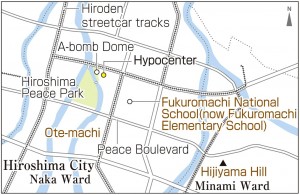Hiroshima: 70 Years After the A-bombing: Close-range Survivors 8
Aug. 26, 2014
Tsunehiro Tomoda, 78: Miracle in basement
At Fukuro-machi National School at time of A-bombing
Off to South Korea 15 turbulent years in a foreign land
Tsunehiro Tomoda, 78, was at Fukuromachi National School (now Fukuromachi Elementary School in Naka Ward), about 460 meters from the hypocenter, at the time of the atomic bombing. A fourth-grader, he was in the basement of the school’s ferroconcrete west wing and miraculously survived. But at the same time he was swept up in turbulent changes. He traveled to South Korea, which had been liberated from Japanese occupation, and experienced the turmoil of the Korean War. “I finally made it back to Hiroshima 15 years later,” he said. He now lives in Osaka.
Late for school, hurried down the stairs
On the morning of August 6, 1945, Mr. Tomoda set off for school with his younger brother, Sachimi, 8. Work was about to begin on clearing up debris from the wooden schoolhouse, which had been torn down to make a fire break. According to a publication issued on the school’s 120th anniversary, 70 students had gathered in the schoolyard.
“We were late, so we ran down to the basement, where the shoe cupboards were. Just as I was about to take my shoes off, there was a flash,” Mr. Tomoda said. His brother, who had gone ahead to the exterior stairway, was killed. Nothing but the teeth of the bodies of the children who lay in the schoolyard was white, Mr. Tomoda said. He took the hand of a classmate who had been with him in the basement, and they headed for Hijiyama.
Mr. Tomoda’s home was in Ote-machi (now part of Naka Ward). His father had died, and he and his brother lived with their mother Tatsuyo, 30, who had taken over her husband’s tailoring business. While walking through the city, which was filled with the stench of death, in search of his mother, Mr. Tomoda ran into a man who boarded on the second floor of their home. The two of them put up a shack, but it was swept away by the Makurazaki Typhoon on September 17. The man, who was from Korea, made up his mind to return there, and Mr. Tomoda went along.
“I suppose he felt it would have been cruel to leave me behind all alone as I had no parents,” Mr. Tomoda said. “I had no choice but to go with him.” They took a fishing boat from the port of Moji in northern Kyushu to Busan, which was filled with Japanese heading back to their homeland. From there they made their way to Seoul. Mr. Tomoda was able to get through checkpoints by addressing the man as father in Korean, as he had been told to do.
He was given the name Kim Hyeongjin. But after his foster father married and had a child he felt uncomfortable living with them and left at the age of 13. He once again found himself alone, this time in a foreign land. He polished the shoes of American military men stationed in Seoul and slept curled up in doorways.
In 1950, when war broke out between U.S.-backed South Korea and Soviet-backed North Korea, Mr. Tomoda witnessed the shelling of Seoul. “It was terrible,” he said. Hostilities were finally suspended in 1953, and he went to live at a bakery. Around the time he turned 20 he began to visit the city government offices in Seoul, seeking to return to Japan, but he was repeatedly turned away. At the time there were no diplomatic relations between Japan and South Korea, and he felt desperate.
Forgotten Japanese
According to an article in the November 13, 1958 edition of the Chugoku Shimbun under the headline “Yearning for homeland,” the door to Japan began to open after Mr. Tomoda sent a letter to the mayor of Hiroshima seeking a copy of his family register. With the cooperation of the mayor of Seoul, Mr. Tomoda returned to Japan in June 1960. A woman named Ryong Bongnyeo wrote many letters on his behalf. “We met while I was working as an errand boy at a market,” he said. “She took me under her wing and treated me like her own son.” By then he had completely forgotten how to speak Japanese.
When he returned to the homeland he had dreamed of, Mr. Tomoda received a lot of attention in the news media and attracted curious stares. “So I went to Osaka, where there were a lot of Koreans,” he said. He married at 30 after being introduced to his future wife by an acquaintance. He worked for a stainless steel processor and raised four sons and a daughter.
Mr. Tomoda described the hardships he went through after the atomic bombing by saying, “I lived prepared to die.” He then talked about his life in a cheerful tone and said, “My karaoke buddies say that I’m still healthy because I had such a rough time when I was young.”
But when it came to the subject of Ms. Ryong, to whom he owed so much, he became emotional. After he was settled in his work and family life, he went to South Korea several times in search of her. In 1995 he appeared on a local television program and was reunited with Ms. Ryong’s daughter. “She said her mother had worried about me until the day she died.” Mr. Tomoda said he had hoped to take his wife Kayoko to South Korea one day, but she died in December of last year at the age of 75. As for being on his own once again, Mr. Tomoda said with a wistful smile, “It’s hard on me all right.”
(Originally published on July 21, 2014)










